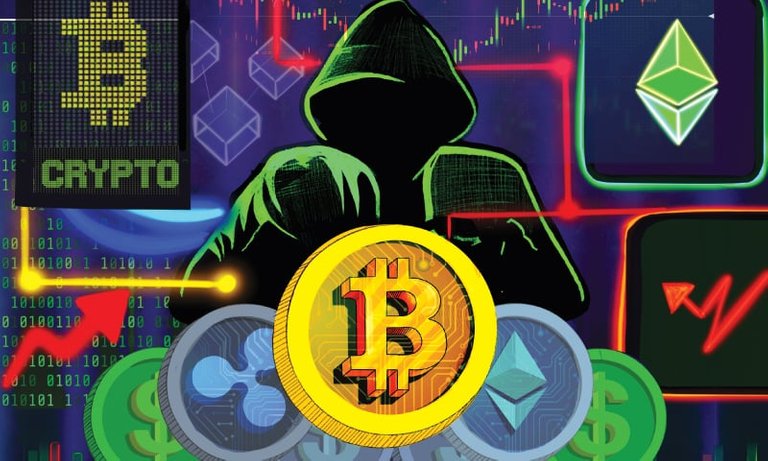Cryptocurrencies such as Bitcoin have taken the world by storm, bypassing state regulators, providing privacy and unprecedented returns on investments as well as a new vision of financial markets. Despite all the hype, however, few people — especially in Pakistan — really know what’s going on behind the buzz. Eos offers a primer…
Bitcoin, the rogue digital currency, is a fixture in the news. Last week, the formal launch of the very first Bitcoin exchange-traded fund raked in investment worth 550 million dollars on just the first day alone. And Bitcoin prices hit an all-time high, crossing 66,000 dollars per Bitcoin.
Crypto-mania is surging in Pakistan too: we reportedly rank third globally, behind India and Vietnam, in crypto adoption metrics. Binance, a cryptocurrency exchange, is reportedly one of our top downloaded apps. And social media is abuzz with investment advice.
Bitcoin enthusiasts are also making a renewed push for crypto-friendly rules and regulations, with the Sindh High Court setting up a committee to look into the matter and to consider the legality of transacting cryptocurrencies.
What started as an underground experiment by a handful of programmers is now a trillion-dollar ecosystem. Bitcoin, valued at 1.2 trillion dollars, exceeds the market cap of Tesla and Facebook, and is significantly bigger than payment giants Mastercard, PayPal and Visa put together. In a recent rally, the combined cryptocurrencies universe reached a value of 2.2 trillion dollars, outpacing tech behemoth Apple — the world’s most valuable company.
There is now a multitude of cryptocurrencies, an entire constellation — a price-tracking website lists over 6,000 entries. While most of these, such as Litecoin and Dogecoin, are little more than Bitcoin copycats, there are also some truly dazzling innovative offerings. For instance, Ethereum goes beyond mere currency and provides a platform to create complex decentralised contracts and applications. Ripple is an efficient medium to send remittances and settle payments. Cardano tops the list of ‘green’ cryptocurrencies, with an energy footprint less than 0.001 percent of Bitcoin. Zcash and Monero incorporate privacy-enhancing technologies.
This ascent is breathtaking. It’s been little more than 10 years since a programmer operating under the enigmatic moniker of Satoshi Nakamoto first popped on to an online forum, recruited a handful of programmers and set out to build a revolutionary new digital payments system.
What started as an underground experiment by a handful of programmers is now a trillion-dollar ecosystem. Bitcoin, valued at 1.2 trillion dollars, exceeds the market cap of Tesla and Facebook, and is significantly bigger than payment giants Mastercard, PayPal and Visa put together.
No one has ever met him or spoken to him, all communication was via forum posts and emails, which ceased shortly after Bitcoin was launched. There has been considerable speculation as to his identity over the years. It is one of the biggest mysteries of this century — who is this unknown man?
Back then, early users were desperate for traction and were literally giving bitcoins away for free on the internet. Today Bitcoin is the best-performing asset class of the decade, with cumulative gains exceeding 20,000,000 percent, far outperforming the stock market index Nasdaq-100, which registered gains of a mere 541 percent. This is unprecedented and there is nothing like it. Small wonder then that our collective fascination with all things Bitcoin, cryptocurrency and blockchain continues to grow in leaps and bounds.
Despite all this hype, few people really know what’s going on behind the buzz. What is Bitcoin? How does it really work? Why was it created? What is all the fuss about? And what does the future hold?
We try to explain.
CRYPTO IN A NUTSHELL
I teach an MS-level course on cryptocurrencies and I usually start the very first class with a question: what is the real difference between Bitcoin and our traditional everyday money?
Bitcoin is digital, students mostly say. Yes, I respond, but so are Mastercard, Visa and PayPal. Bitcoin only exists online, is the second most common response. True, but in reality, most of the world’s money supply is digital. Only an estimated eight percent of the world’s money really exists as hard physical cash.
Another typical refrain: there’s nothing behind Bitcoin, it is not backed by gold or reserves. Yes, also true, but no major currency today is backed by gold or tangible reserves. Bitcoin is decentralised, some say. Yes, but what does that really mean? How does that make Bitcoin uniquely different from every currency in the world?
The simple difference is this: we derive our trust and confidence in existing currencies — and in the larger financial ecosystem — as a result of government oversight and regulation. If some rogue party starts printing currency notes or hacking into banking databases, reversing transactions or inflating account balances, we expect the government will use its full might to track them down and lock them away for a very long time.
We expect the government to carefully manage the money supply to cope with inflation and economic stress. In short, our traditional currencies are rigorously policed by government writ.
In stark contrast, there is no government stick behind cryptocurrencies. Bitcoin uses cryptography — the mathematical techniques used to secure information — to ensure that everyone follows the rules. Users manage their own coins. The network collectively validates and processes all transactions. The money supply is controlled by an algorithm and cannot be manipulated. Government and banks have been cut out of the equation entirely. In this sense, Bitcoin is far more than just a novel technology — it is an entirely different paradigm for money.
REINVENTING MONEY
